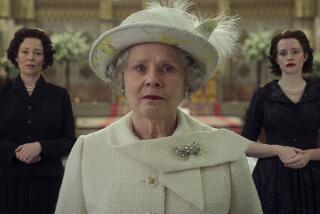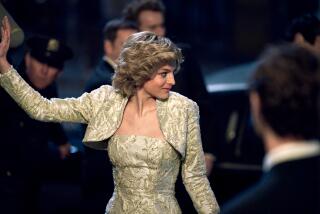She Was No Victorian : QUEEN VICTORIA; A Portrait, <i> By Giles St. Aubyn (Atheneum: $24.95; 672 pp.)</i>
- Share via
Toward the end of Queen Victoria’s 64-year reign, an elderly English gentlewoman attended a performance of the tempestuous Sarah Bernhardt in “Antony and Cleopatra.” When the final curtain was rung down, the old lady turned to her companion and said: “How different, how very different, from the home life of our dear Queen.”
The monarch who came to symbolize traditional family values and middle-class morality grew up under conditions that today’s social workers would find disturbingly familiar. The child of a late second marriage, she had two much older half-siblings; her father died when she was 8 months old, and until she married, she shared a bed with her mother. Worst of all, she had three uncles who gave “dysfunctional” new meaning: One was a bigamist, another fathered 10 illegitimate children by his mistress, and the third raped his sister and murdered his valet.
Uncles George IV and William IV both died without legitimate heirs. The third uncle, the Duke of Cumberland, “the most hated man in England,” would have succeeded to the throne if his older brother, the Duke of Kent, had remained single and gone on living with his French mistress in Paris. But the middle-aged Kent married a widow, Princess Victoire of Saxe-Coburg, and sired a daughter. According to the English law of succession, the daughter of an older brother takes precedence over his younger brothers and their sons, so the psychotic Cumberland was shunted aside in favor of Victoria, who ascended the throne in 1837 at age 18.
Her middle name was Alexandrina after her godfather, Czar Alexander I. Her nanny tied a sprig of holly under her chin to make her hold her head high, one source of the overpowering “presence” that atoned for her lack of beauty. Her mother was once eyed by Napoleon as a possible successor to Josephine, but Victoria, less than five feet tall and cursed with coarse ruddy skin, “looked like a cook.” Her best feature was her voice; “like a silver stream flowing over golden stones,” according to actress Ellen Terry, though a lady-in-waiting testified that she spoke with a peculiar accent, part Scottish and part foreign, and had a habit of stringing her thoughts together with a German so , pronounced tzo .
In a perceptive new biography, Giles St. Aubyn, author of several other books on the period, including “Infamous Victorians,” paints a subtle but lively portrait of a woman composed of equal parts masochism and egotism, who made the seemingly impossible combination work. Never having known her father, “she had an appetite for submission to dominant males.” The moment one entered her life she eagerly adopted his ideas, convincing herself that he could do no wrong--which meant that she could do no wrong.
Her first influential father figure was her first prime minister, the cynical Lord Melbourne (husband of the wacky Lady Caroline Lamb, Lord Byron’s mistress), whose stern political advice--”For God’s sake, don’t do that, Ma’am”--was balm to Victoria’s paternal yearnings even as it sharpened her governing talents. This irresistible psychological twofer started something that is with us yet. Melbourne, not Prince Albert, was the first male to find himself on the receiving end of those exalted gazes, “with adoring eyes like one of Landseer’s spaniels,” that Victoria perfected and American political wives try so hard to duplicate. She did it so often and so publicly that the populace nicknamed her “Mrs. Melbourne.”
She switched her allegiance the moment “dear, dear Albert” arrived from the German duchy of Saxe-Coburg, the tiny exporter of royal consorts that Bismarck called “the stud farm of Europe.” She had met him once before when he was 16 and very fat, but at 20 he was a “beautiful, perfect angel ,” though some crusty confreres of the old Duke of Wellington said he looked like a tenor.
Albert’s plain living and high thinking did not come naturally to the night-owl Victoria (“danced til quarter to three,” she noted in her diary). She abhorred long sermons and Sunday blue laws, and held to “a Christology so reductionist as to verge on Unitarianism.” She was also remarkably indulgent toward certain Highland habits:
“The Gillies’ Ball at Balmoral was notoriously bacchanalian. The Queen’s dinner began about two hours after the festivities began and many of those who waited on her were clearly the worse for drink. Loud crashes could be heard off stage as plates and dishes were dropped, and footmen would often pour wine all over the table in their effort to fill a glass. The Queen, however, would keep the conversation going as if nothing whatever was wrong, rather as a military chaplain might say prayers while shells exploded round him.”
Buying Balmoral was Albert’s idea, but Victoria one-upped him by turning Scottish with a vengeance. Nine bagpipers marching around and around the dinner table “nearly blew our heads off,” said a guest. Czar Nicholas II said it was “colder than Siberia.” Even with snow on the ground, Victoria kept the windows open. Lord Clarendon, whose toes developed frostbite during dinner, described the drawing-room fire as “two little sticks which hissed at the man who attempted to light them.” Finding a hearth fire in her son’s room, the Queen ordered him to throw his wash water on it. She forbade a room temperature above 56 degrees; if it rose higher she had herself surrounded with buckets of ice, while Albert wore a fur coat indoors and warmed his fingers on his reading lamp so he could hold his pen.
She survived seven assassination attempts, six bullets that missed and one assailant, armed with a walking stick, who hit her on the head and knocked her out. She hated that one the most because it hurt her ego: “For a man to strike any woman is most brutal,” she wrote.
A greater blow to her ego was pregnancy (“The only thing I dread,” she wailed in her diary), which brought on such severe attacks of postpartum depression that Albert feared for her sanity. She felt “pinned down . . . wings clipped . . . only half oneself . . . like a cow or a dog, when our poor nature becomes so very animal and unecstatic”--and when a queen is revealed to be exactly like any other woman.
Of her nine offspring she said bluntly, “I have no tendre for them till they have become a little human; an ugly baby is a very nasty object--and the prettiest is frightful when undressed.” Breast-feeding was an “insurmountable disgust” that forced women “to make cows of themselves.” She “found no especial pleasure or compensation” in the company of her children and “only very exceptionally” did she find “intimate intercourse with them either agreeable or easy.”
She supposedly liked sex, though the author raises doubts with his conflicting quotations. He cites her description of pregnancy as “a complete violence to all one’s feelings of propriety (which God knows receive a shock enough in marriage alone),” yet he claims that “she possessed a particularly passionate nature--some said she inherited the sexual libido of her Hanoverian ancestors--and was consequently tormented by unfulfilled desires” after Albert’s death. Since the book contains no notes, we don’t know how he knows this, and our skepticism mounts when he quotes her response to the doctor who warned her not to have any more children. “Can I have no more fun in bed?” she is to have said. That sounds jarringly modern.
Nonetheless, this is a big book with a glorious sweep and many fresh insights. St. Aubyn thinks Victoria may have worn down Albert’s nerves with her blind love (“she worshipped him, but idolatry was no substitute for understanding”) but rejects the widespread feeling that her mourning was touched with necrophilia. Grief was simply the only emotion a queen was permitted; moreover, her seclusion actually helped preserve the mystical aspect of monarchy in an increasingly egalitarian age.
The author’s unabashed affection for Queen Victoria is especially welcome in our debunking times. Like most of the Queen’s biographers (including the initially hostile Lytton Strachey), St. Aubyn likes her so much that we end up liking her, too. Those who think of Victoria as the prude who put pantalets on piano legs will be in for a pleasant surprise as they read this very human book, especially one raucous story:
Conversing with a deaf admiral who was describing the salvage of a sunken ship, the bored Queen tried to change the subject with an inquiry about his sister. He evidently did not hear her, for he replied: “Well, Ma’am, I am going to have her turned over and take a good look at her bottom and have it well-scraped.” Whereupon the woman whose name is a synonym for prudery laughed until the tears ran down her face.
More to Read
The biggest entertainment stories
Get our big stories about Hollywood, film, television, music, arts, culture and more right in your inbox as soon as they publish.
You may occasionally receive promotional content from the Los Angeles Times.










